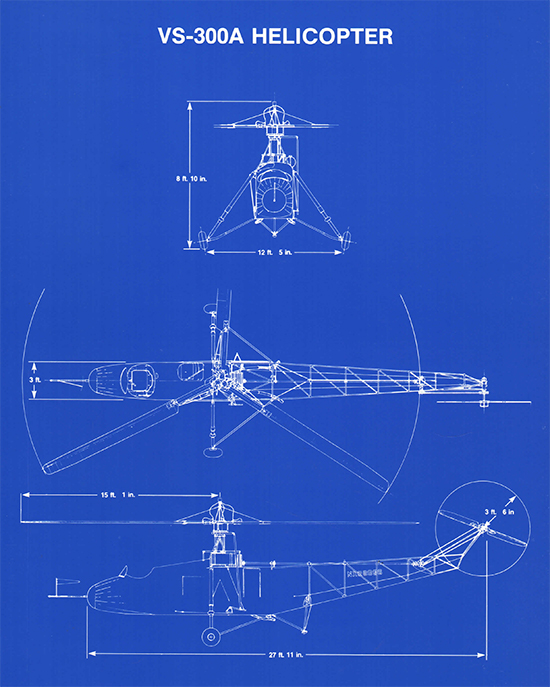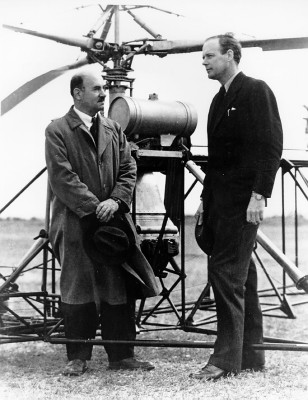Sikorsky Aviation History
VS-300: The First Practical Helicopter
by Igor Sikorsky, January 1941
Igor I. Sikorsky’s VS-300 was America’s first practical helicopter and the first successful helicopter in the world to perfect the now familiar single main rotor and tail rotor design. The VS-300 was first flown (tethered) on September 14, 1939 and the first untethered flight was on May 13, 1940. Testing continued and on May 6, 1941, Sikorsky piloted the VS-300 to a new world helicopter endurance record of 1 hour, 32 minutes and 26 seconds. The VS-300 underwent several major configuration changes until December 8, 1941 when it was flown in its final configuration; a single main lifting rotor with full cyclic-pitch for both roll and pitch control and a single tail rotor for both directional control and anti-torque. On October 7, 1943 the VS-300 was presented to Henry Ford and his Edison Museum in Dearborn, Michigan. During her career the VS-300 had logged 102 hours, 35 minutes and 51 seconds. The development of the VS-300 established the concepts and principles that were utilized in the design of the VS-316 (R-4), the world’s first production helicopter. Thus began the world’s helicopter industry.
Presented at the Rotating Wing Aircraft Meeting of the Institute of the Aeronautical Sciences, 29 January 1941

The modern idea of air transportation is nearly always associated with the use of large fields for the departure and arrival of ships. As a general rule, an air traveler cannot start from his residence and, reach his desired destination with an airplanes while he can usually do so with an automobile. However the dreams of the past and the positive prediction for the near future foresee a different type of aircraft that could be safely operated from very small spaces between buildings or trees, or from small platforms on tops of buildings. Such aircraft would open a vast now field of usefulness and could become a very valuable vehicle of transportation for use by the average individual, as well as for a number of government uses.
 The object of this paper is to describe the development of such aircraft, the present work was started in the year 1909 by the construction of two experimental helicopters and was completed by the recent development of a simple and very satisfactory Model VS-300 helicopter.
The object of this paper is to describe the development of such aircraft, the present work was started in the year 1909 by the construction of two experimental helicopters and was completed by the recent development of a simple and very satisfactory Model VS-300 helicopter.
From March to October 1940, this aircraft was extensively test flown and made several hundred flights. The ship demonstrated Its ability to rise straight up, climb vertically or obliquely, hover over one spot for several minutes under various conditions of weather, ranging from dead calm to fresh gusty wind of some 25 miles per hour. The ship was also flown forward, backward, and sideways; it made a number of take-offs and landings from very small spaces between buildings, from a parking lot, the major part of which was occupied by automobiles from a very small space situated between a fence and vegetable garden, etc. In fact, it thoroughly demonstrated not only the possibility but the practicability of operating the aircraft from small spaces in a backyard in any weather, except unusually strong winds.

While the present VS-300 helicopter has been built as an experimental model, it may be considered that it definitely proved the immense practical possibilities of direct lift aircraft in general, as well an the correctness and soundness of the particular proposed type, the VS-300 may be considered as the first successful single main rotor helicopter in the world, this characteristic permitted obtaining the necessary lift and control with the use of a very simple mechanism which offers possibilities of inexpensive production and easy maintenance.
The ship consists mainly of a tubular welded framework that includes near its center of gravity a 90 horsepower engine of the Aircooled Motors Corporation, and a simple transmission which sends most of the power into the vertical shaft of the main lifting rotor. A light horizontal shaft carries a small part of the-power, to the and of the fuselage on which are situated the three auxiliary rotors which are used for the control of the aircraft and for the compensation of the torque of the-main rotor. It is by the use of these auxiliary rotors that normal airplane stick motions can be duplicated in order to control the helicopter whether it is hovering motionless over a given spot, traveling forward, sideways, backward, upward, or downward. Based on the action of rotating airscrews, the effectiveness of control remains substantially the same when the aircraft is hovering over one spot, or when it moves at different speeds.

The control of the VS-300 is obtained by changing the “pitch” of the three auxiliary rotors, thus moving the control column or “stick” from side to side differentially changes the pitch in the horizontal auxiliary rotors, causing a lateral, or aileron, reaction. By moving the stick forward and backward., the pitch on the two horizontal auxiliary rotors is changed simultaneously in the same direction, thereby achieving longitudinal, or elevator reaction. Rudder action is achieved by foot pedals connected to the pitch control of the vertical auxiliary rotor. This vertical rotor thus serves a dual purpose, namely, that of counteracting the torque produced by the single main lifting rotor, and as a means of changing the direction of flight. These three auxiliary rotors have a diameter of 7-1/2 feet, are lightly loaded, and rotate approximately four times as fast as the main rotor.
The main lifting rotor, as its name implies, furnishes the major part of the lifting force and has three blades of fourteen foot radius. This lifting force can be so varied both in magnitude and direction as to produce hovering, vertical, forward, sideways and backward flight. The variance of the magnitude of the lift to accomplished by changing the-pitch of the three main rotor blades so as to cause the helicopter to either ascend, descend, or hover. The direction of flight is governed by the three auxiliary rotors, it being only necessary to slightly tilt the whole ship in the desired direction of flight, thus, tilting the helicopter slightly forward by pushing the stick forward, forward flight is achieved.
Power in the VS-300 is transmitted from the engine to the main lifting rotor by means of Vee-belts which drive the reduction gears attached to the main shaft. The two horizontal auxiliary rotors are driven by Vee-belts off a drive shaft which is coupled to the main gear drive, and the rear vertical auxiliary rotor to driven through bevel gears from an extension of the aforementioned drive shaft. This whole drive system is connected to the engine drive by means of a “free wheeling” unit, If the number of r.p.m.’s of the main rotor were reduced below a definite value, an automatic device would change the pitch of the main rotor; therefore, should engine failure occur, all the rotating surfaces continue to operate in auto-rotation, thus making an autogiro out of the helicopter. The feature allows for safe landings without power.

A novel and interesting feature of the VS-300 is the method of synchronization between the engine throttle, the main lifting rotor and the two horizontal auxiliary rotors. This synchronization becomes very necessary when switching from hovering, or vertical flight, to say forward flight, since the pitch of the main lifting rotor in naturally greater when producing enough lift to hold the craft motionless, or while ascending vertically, than when forward motion in introduced. However, since increasing the pitch of the main rotor blades means additional horsepower in order to maintain a constant R.P.M., the pitch control lever is connected to the engine throttle, thus an increase or decrease in pitch automatically means an increase or decrease in power transmitted to the main rotor. On the other hand, any variance of lift and power occasioned in the main rotor alone, unless the two rear horizontal auxiliary rotors were synchronized with it, would produce either a tail up or tail down condition, therefore, the main pitch control is connected to the longitudinal control; In this manner, level flight is assured at all times. Of course the pilot can vary the actual amount of power of the engine at any time by a separate hand throttle.
The necessary flight controls thus number essentially three; namely, the control column, or stick, the rudder pedals, and the main pitch control lever, It can be readily seen that flight is possible without taking the pilot to other than normal airplane flight reactions. A great advantage of the control system of the helicopter of this type over that of the conventional fixed wing airplane, in that in the former the “feel” and effectiveness never vary, regardless of the attitude of the craft, since the control surfaces are always rotating at a speed far in excess of the stalling speed of their particular airfoil section.
The following are few of the more important flights made on the VS-300 helicopter during the summer and fall of 1940:
On July 18th, a 15-minute flight was made during which time the ship was practically stationary all the time, hovering over one place,
On September 6 and on October 14, flights of 15 and 14 minutes respectively were made and the ship was flown over the field at a speed mostly between 30 and 45 miles per hour, making turns in both directions and raking several times a figure eight In flight.
During the flights the ship reached an altitude of between 80 to 100 ft. On January 10, 1941 the VS-300 made a flight of 25-1/2 minutes duration, This is believed to be the longest flight ever made on a helicopter in America.

During several of the flights it was possible to approach, with the helicopter in plain flight, a man standing on top of a pile of rocks, or on another place, and enable him, without moving from his place, to load or unload a suitcase on the machine. On this flight it was necessary to approach the man and after the suitcase was loaded to move directly backward. Most of these flights were purposely made over such places where the helicopter could not be landed. The completely satisfactory control of the machine which permitted to approach a person hover for substantial periods, within loss than 2 ft from the desired place, was therefore positively demonstrated, It may, therefore, be considered as definitely proven that a helicopter with a control of such type will successfully solve all control problems connected with operating an aircraft from congested places between buildings or trees, will permit landing on platforms situated on buildings or on board ships, etc. There can be no doubt that an aircraft of such characteristics will open a most important and large now field of air travel.
